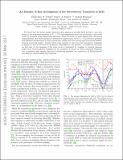Inelastic x-ray investigation of the ferroelectric transition in SnTe
Abstract
We report that the lowest energy transverse-optic phonon in metallic SnTe softens to near zero energy at the structural transition at TC=75K and importantly show that the energy of this mode below TC increases as the temperature decreases. Since the mode is a polar displacement this proves unambiguously that SnTe undergoes a ferroelectric displacement below TC. Concentration gradients and imperfect stoichiometry in large crystals may explain why this was not seen in previous inelastic neutron scattering studies. Despite SnTe being metallic we find that the ferroelectric transition is similar to that in ferroelectric insulators, unmodified by the presence of conduction electrons: we find that (i) the damping of the polar mode is dominated by coupling to acoustic phonons rather than electron-phonon coupling, (ii) the transition is almost an ideal continuous transition, and (iii) comparison with density functional calculations identifies the importance of dipolar-dipolar screening for understanding this behavior.
Citation
O'Neill , C D , Sokolov , D A , Hermann , A , Bossak , A , Stock , C & Huxley , A D 2017 , ' Inelastic x-ray investigation of the ferroelectric transition in SnTe ' , Physical Review. B, Condensed matter and materials physics , vol. 95 , no. 14 , 144101 . https://doi.org/10.1103/PhysRevB.95.144101
Publication
Physical Review. B, Condensed matter and materials physics
Status
Peer reviewed
ISSN
2469-9950Type
Journal article
Description
Support from the Royal Society RG-150247 (A.H.), Engineering and Physical Sciences Research Council EP/L0151101/ and EP/J00099X (C.O.N.) and EP/I031014 (A.D.H.), and the Carnegie Trust for the Universities of Scotland (C.S.) is acknowledged.Collections
Items in the St Andrews Research Repository are protected by copyright, with all rights reserved, unless otherwise indicated.

